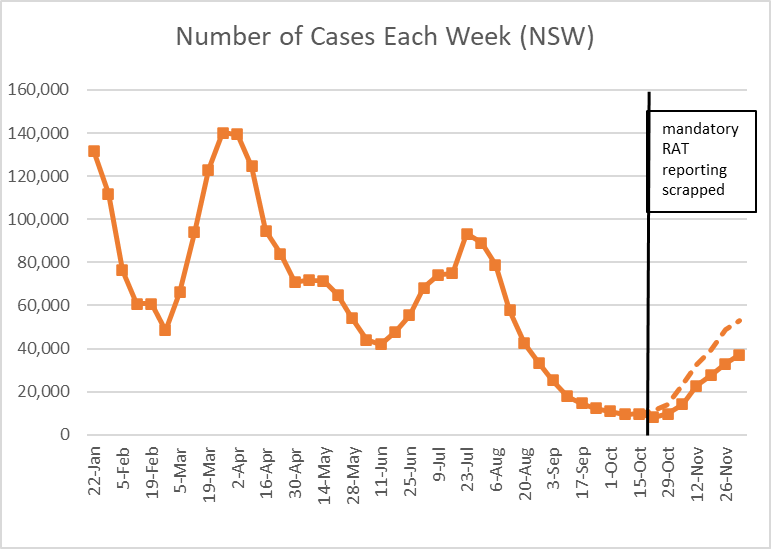
The NSW Health epi report for the week ending 3 December is now out.
A thread/
#Covid19Aus #Covid19NSW
You can find the full report here...
health.nsw.gov.au/Infectious/cov…
A thread/
#Covid19Aus #Covid19NSW
You can find the full report here...
health.nsw.gov.au/Infectious/cov…
Reported cases are up 13% this week, a bit of a slowing in the rate of growth.
I've also estimated case numbers had mandatory reporting of RATS continued (dashed line). Approx 53,000 cases compared with 37,000 actual.
I've also estimated case numbers had mandatory reporting of RATS continued (dashed line). Approx 53,000 cases compared with 37,000 actual.

NSW Health has included a graph of furloughed health care workers, which provided a good correlation to case numbers prior to scrapping mandatory RAT reporting.
Hard to read off this graph, but it indicates maybe 55,000 cases had RAT reporting continued, so similar
Hard to read off this graph, but it indicates maybe 55,000 cases had RAT reporting continued, so similar

The number of PCR tests is only a little higher than last week, but positivity has again increased - now 20%. 

New video out by Dr Chant this morning, saying she expects the peak "in the coming week or so".
https://twitter.com/NSWHealth/status/1600641319298568193?s=20&t=u_hPE__00Z5VFdSHVOgVjQ
I thought I had won the "hospital admissions are lower this week" battle as it wasnt their leading bullet point this week. But no, it was still there, just relegated to 5th spot this week.
Hospital admissions have not decreased. They have increased by 15%
Hospital admissions have not decreased. They have increased by 15%

For my new followers, this is what the previous tweet is all about.
https://twitter.com/KarenCutter4/status/1594928263645626369?s=20&t=u_hPE__00Z5VFdSHVOgVjQ
Variant picture has changed a bit.
BQ.1.1 still at about 18% of cases.
BA.5 reducing and now only about 18% of cases.
BR.2 growing and about 32% of cases.
BA.2.75 now lower at about 10%.
BQ.1.1 still at about 18% of cases.
BA.5 reducing and now only about 18% of cases.
BR.2 growing and about 32% of cases.
BA.2.75 now lower at about 10%.

And this is my last NSW thread for a few weeks as I'm off on holidays. I'll be back mid-January.
Wishing everyone a covid-free christmas and new year!
ends/
Wishing everyone a covid-free christmas and new year!
ends/
• • •
Missing some Tweet in this thread? You can try to
force a refresh













